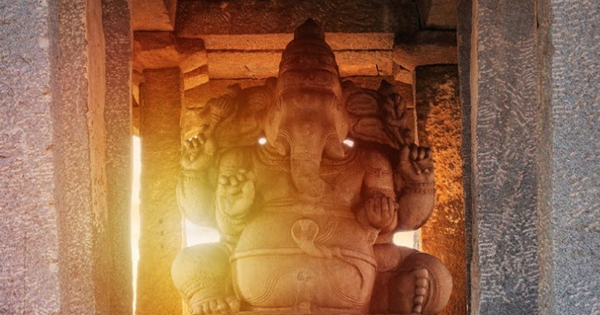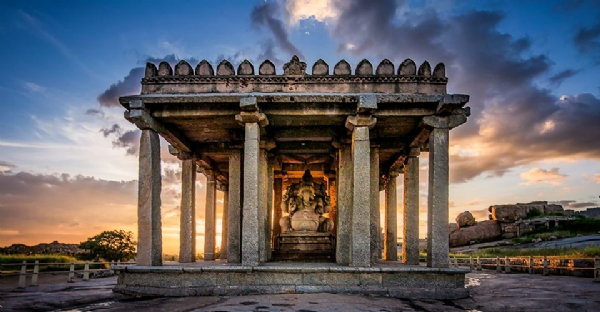Gajanana Namostute: Hampi's Majestic Ganesha & Sasivekalu Kadalekalu Temple's Timeless Tale
23 Sep 2023 14:24:23
Amidst the captivating ruins of Hampi, a UNESCO World Heritage Site in Karnataka stands the Sasivekalu Kadalekalu Ganesha Temple, a testament to the region's rich historical, mythological, and religious heritage.

The history of the Sasivekalu Kadalekalu Ganesha Temple is closely tied to the Vijayanagara Empire, one of the most powerful and influential kingdoms in South India during the 14th to 16th centuries. This temple, along with several others in Hampi, was built during the reign of the Vijayanagara kings, who were great patrons of art and religion.
The name "Sasivekalu Kadalekalu" translates to "mustard seed and gram" in Kannada, which aptly describes the two colossal stone statues found within the temple complex. These statues, one representing Bhagwan Ganesha and the other a guardian deity, are massive in size and exemplify the architectural grandeur of the Vijayanagara era.
The temple's historical significance lies in its status as a place of worship that has withstood the test of time, enduring the rise and fall of empires. It serves as a living reminder of the architectural and cultural excellence of the Vijayanagara Empire.
Mythological Significance
The Sasivekalu Kadalekalu Ganesha Temple is steeped in mythology and legends that lend it an air of mysticism. Bhagwan Ganesha, the elephant-headed deity, holds a special place in Hindu dharma as the remover of obstacles and the bestower of wisdom. It is believed that the temple's giant Ganesha statue, intricately carved from a single block of granite, was installed to invoke the blessings of the deity for the success of the Vijayanagara kings' endeavors.
One popular mythological story associated with the temple involves the demon Ganasura, who was causing havoc in the region. Bhagwan Ganesha, in his divine form, is said to have defeated the demon and restored peace to Hampi. As a result, devotees flock to the temple to seek Bhagwan Ganesha's blessings and protection from obstacles in their lives.
Religious Significance
The Sasivekalu Kadalekalu Ganesha Temple continues to be a place of religious significance and devotion. Devotees and tourists alike visit the temple to pay homage to Bhagwan Ganesha and marvel at the colossal statue that stands at the heart of the complex.
The temple also plays a significant role during Ganesh Chaturthi, a Hindu festival dedicated to Bhagwan Ganesha. During this auspicious time, the temple comes alive with colorful decorations, offerings, and festivities. Devotees gather to offer prayers and seek Bhagwan Ganesha's blessings for success, wisdom, and the removal of obstacles in their lives.

The temple's serene and spiritual ambiance, coupled with its historical and mythological connections, make it a must-visit destination for pilgrims and tourists exploring the cultural heritage of Hampi.
The Sasivekalu Kadalekalu Ganesha Temple of Hampi, Karnataka, stands as more than just a place of worship; it is a living embodiment of the intricate interplay between history, mythology, and religious significance. Its architectural splendor, deeply rooted in the Vijayanagara Empire's legacy, serves as a poignant reminder of the region's historical tapestry. The temple's association with Bhagwan Ganesha and the mystical legends surrounding it adds an aura of transcendence that continues to captivate the hearts of devotees and visitors alike.
For centuries, the Sasivekalu Kadalekalu Ganesha Temple has remained a source of spiritual solace, cultural preservation, and communal harmony. It remains a symbol of unwavering faith and devotion, transcending the confines of time to connect generations to the divine. As devotees gather to seek the blessings of Bhagwan Ganesha and immerse themselves in the cultural richness of Hampi, the Sasivekalu Kadalekalu Ganesha Temple remains an enduring beacon of spiritual enlightenment and historical heritage in this enchanting corner of India.
--